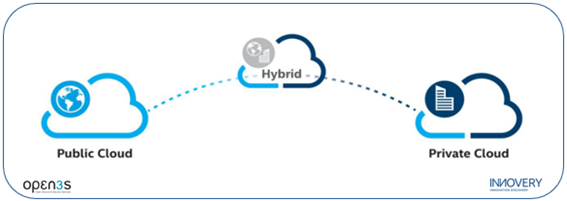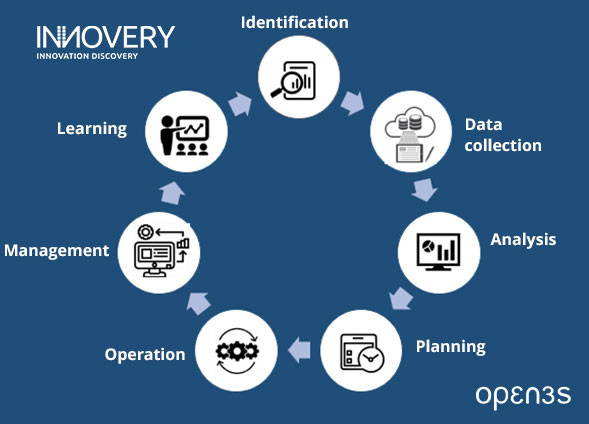INTRODUCTION
With the increasing demand for the application of Digital Transformation processes in which organisations are engaged, one of the main requirements is the modernization of infrastructures. In this regard, the proposed solution is the adoption of cloud models through migration processes as a key strategy, whose implementation represents an important challenge both at operational and business level.
In this article, we will explain the different stages of development of the journey to successfully complete a process of migration and modernization of our infrastructures, within the scope of adopting any cloud model in its different types: public, private and hybrid.

As we mentioned, adopting a cloud model is an important step in the digital transformation process, therefore organisations need to ask the following questions:
- What are the advantages of adopting a cloud model?
- What is the current situation of our infrastructure?
- How can we collect information about the current situation of our infrastructure?
- How to turn the collected information into a cloud adoption process?
- What are the different components of the cloud adoption process? Delivery, service, resources and budget.
- How do you carry out the process of adopting a cloud model?
- What did we learn from this process?
LET’S START THE JOURNEY
In order to answer the above questions, the following steps were defined in the process of adopting a cloud model:
- Identification.
- Data collection.
- Analysis.
- Planning.
- Operation.
- Management.
- Learning.

As follows we explain what each of these phases consists of:
Identification
In this phase it is necessary to identify the business objectives and understand the current situation of the infrastructure. In this case, the main success and measurement criteria will have to be established once the process has entered the operational phase. It is necessary to define the approach to the cloud migration with regard to decision-making and data collection, identifying the persons and processes to be involved. Finally, the environments and applications to be migrated must be identified according to the following features:
- Architecture.
- Cloud migration maturity model.
- Performance.
- Security.
- Scalability.
- Strategic relevance.
- Workload of IT operations.
Data collection
The necessary tools and methodologies are defined to collect information on the current situation of the infrastructure and the required features according to the identification phase.
In this phase, functional and non-functional aspects as well as security and high availability are analysed. The obtained data will help us to answer the following questions:
- Which environments can adopt the cloud model?
- Where will these environments be hosted and with which cloud model (private, public or hybrid)?
- Where to start? Identify priorities for migration and data collection.
Analysis
Once the data have been collected, it is necessary to analyse them during this phase in order to understand their current status. Such information will be necessary for the planning phase.
During this phase, success criteria metrics have to be analysed in more detail. In this phase, the feasibility of adopting a cloud model for the analysed environments and applications is identified.
In this analysis process, the following results were identified:
- Feasibility analysis.
- Dependencies analysis.
- Identification of metrics (KPIs).
- Classification of environments and workloads.
- Standardization of governance.
Planning
In this phase, after analysing the infrastructure, environments and applications, it is necessary to plan the processes involved in adopting the cloud model. The delivery model, service model, implementation model, resources plan and budget for this process are planned and assessed.
A perspective on the process should be prepared, in order to review and align the results with different evaluation metrics, as well as the preparation of business-level use cases.
The following outcomes were identified in this planning process:
- Design of a procedure (runbook) for planning tests for each implementation environment.
- Design of a metrics evaluation plan (KPIs).
- Evaluation plan for a business use case.
- Resources and costs optimisation plan.
- Definition of the risk factors and mitigation plans for the specific detected risks.
Operation
Once the previous steps have been successfully achieved, the process of adopting a cloud model by migrating the analysed environments will begin. This process should be quick and iterative, with the application of the following steps: planning, implementation, testing/validation, put into production, retrospective evaluation and learning.
In this operational phase, a key aspect is the automation of the often complex migration processes. Therefore, a perfect automation of tasks is important to ensure success at this stage.
Management
A governance methodology ensures standardised processes, policies and procedures, with the main objective of creating a structure for governance and resources management, as well as identifying infrastructure and security problems and incidents. In addition to the governance of resources, this process must also include methods of corporate culture and collaboration to ensure the success of the entire process.
Learning
As in any implementation process and in the context of the roadmap with the different proposed phases, it is necessary to continuously evaluate the process according to the defined evaluation metrics. In this phase, the adoption process towards the cloud and the implemented migration processes are evaluated, as well as the optimisation of the environments once the process is completed, so as to ensure the continuous evolution of the implemented model.
CONCLUSIONS
The adoption of a cloud model in organisations is a complex issue that requires great effort and investment, so it is essential that this process is properly defined, through the use of best practices and the execution of the steps described above.
Furthermore, it is important to have a well-defined knowledge of the existing cloud models, services and types, in order to be able to make the best decisions within this process of modernising infrastructures in organisations.
Within Innovery’s Hybrid Cloud division, we help our customers in this journey towards adopting a cloud model as part of their Digital Transformation processes and modernization of their infrastructures, by relying on our expertise in infrastructures and knowledge of the different models and types of currently existing clouds.

Carlos Zavala
Head of Division Hybrid Cloud, Innovery



